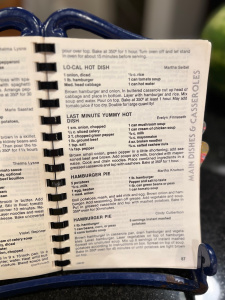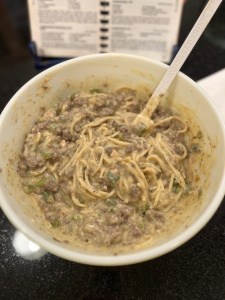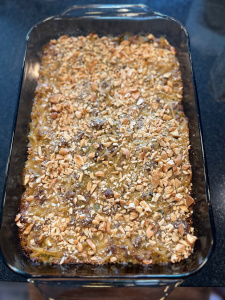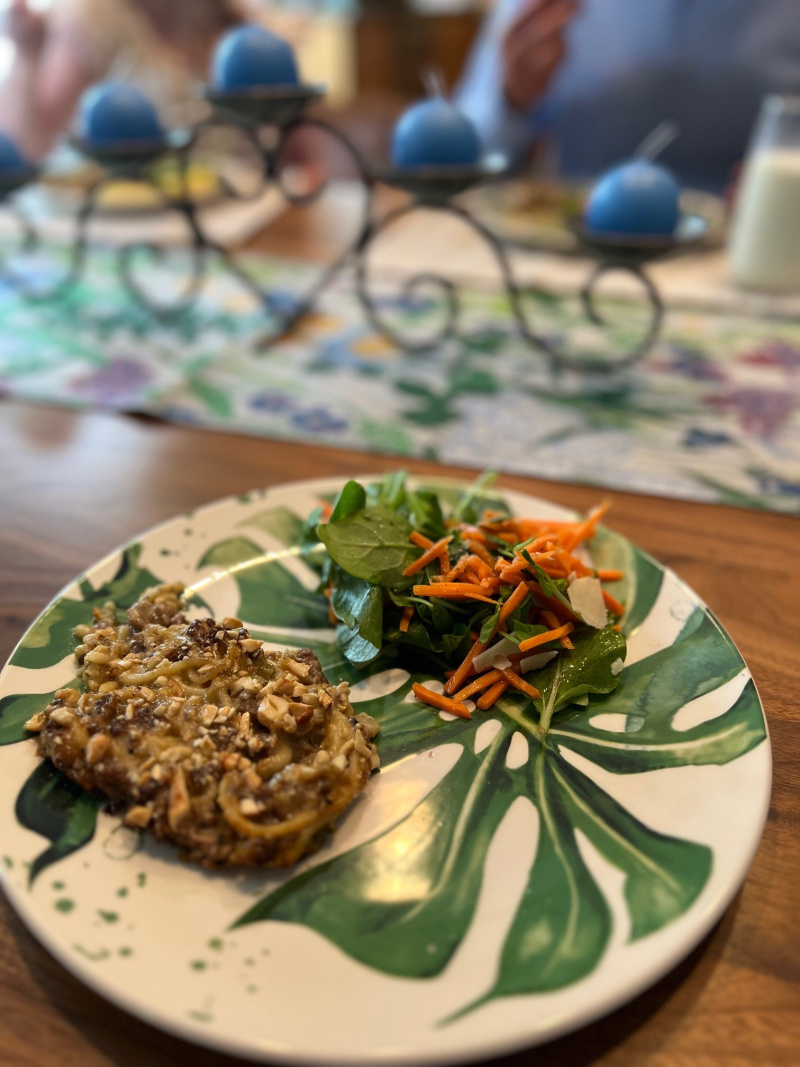Last week I made two hotdishes, both from the “Main Dishes & Casseroles” section, both disappointing. I planned to make a casserole for my friend Gay, who had just had surgery, and so I tried out a recipe on Tuesday to see if I should make it again for her and her family on Thursday. Unfortunately, it was okay, but a bit strange in consistency, and so I decided to regroup and make another recipe that should have been great without testing—tater tot hotdish. I’ve made dozens of variations on tater tot hotdish; it should have been fine.
But it was an abomination.
Last Minute Yummy Hotdish

Contributed by Evelyn Finneseth, this casserole appears to use a variety of items most people may have had on hand—common vegetables like onion, celery, and green pepper (the Holy Trinity of Cajun cooking), ground beef, milk, mayonnaise, noodles, and canned cream soups—mushroom and chicken. Cashew nuts also may a common pantry staple for protein-based snacking. The recipe called for 4 ounces of broken noodles, which I interpreted to be spaghetti noodles broken in pieces. It was a fun excuse to get out our kitchen scale!

The first steps were fairly clear, though I wasn’t sure about some of the phrasing: “Brown small onion, green pepper in a little shortening; add seasoned beef and brown.” Once again, I used olive oil and butter (to reduce the smoke point of the EVOO), rather than shortening. I also assumed that the omission of celery from the instructions was accidental and included it with other fresh veggies. How is the beef seasoned, I wondered? In the package? In the pan? When? I decided to add the ground beef to the pan and then season it with kosher salt, pepper, and a small amount of garlic salt.


The next step led to more questions: “Add soups and milk, blended with mayonnaise. Cook and drain noodles. Place combined ingredients in a greased casserole.” Did this mean for me to add the soup/milk/mayo mixture to the pan? Or to add the browned mixture to a bowl for mixing with the soup mixture and the noodles? I eventually decided to whisk the liquid mixture in a bowl, then to add the browned veggie and beef mixture to it, as well as the noodles.



The unbaked mixture looked good in the bowl with the noodles, with a creaminess that vaguely resembled carbonara. However, it looked much less nice in the pan itself—the brown color of the mushroom soup and the ground beef became more prominent when spread out along the bottom of my Grandma Martha’s yellow Pyrex baking dish.

As instructed, I topped it with three-quarters of a cup of cashews, but it wasn’t clear whether these should be whole or pieces. After a brief internet search for cashew-topped casseroles, it appeared that most of them used pieces, and so I gave them a chop.

Reflections
I prepared this late in the evening on Tuesday and baked it for our lunch on Wednesday. With the cashew nuts toasted and rising from the surface for some visual texture, the casserole looked nice in the baking dish. But it looked less appetizing when served. I was able to cut squares because the ingredients held together, but they were thin and flat. With no vegetables visible, it resembled a dark brown glob of noodle, beef, and nut.


The taste was fine but much too salty. That might have been my fault—perhaps I oversalted the mixture during the browning stage. But it also might have been too large a quantity of cashews, mayonnaise, and two cans of soup cut with only half a cup of milk. The texture was “interesting,” to use a passive-aggressive expression common to the region, meant to denote strangeness. Since it didn’t have enough pasta to resemble a baked-pasta dish, bites consisted of ground beef, a noodle or two, and the binding mixture, which seemed to be doing its job. This is undoubtedly an effect of the mayonnaise, which, Harold McGee explains in On Food and Cooking: The Science and Lore of the Kitchen, “reacts usefully to heat. . . . it moderates the heat, puffs up and sets into a rich coating” (634). Serving it with greens topped with Aunt Ellen’s Carrots cut the salt somewhat.
This ended up not being the most magical twentieth-anniversary lunch (okay, I’m being grandiose here—we all just happened to all be home for lunch, and I happened to have something I needed to cook. The three of us went out for a delicious, fancy celebratory dinner that evening). To pass the wealth around, I cut the remaining casserole into three pieces—a small one that I decided to try again for lunch the next day (it was harder, not better), and two more larger pieces to send for taste-testing with my mother and my sister. Both of them reported similar notes—tasty but salty.
I’m fine with never eating this again.
Contributor
Evelyn (Mikkelson) Finneseth was from Deering, ND, a town both thirty minutes and thirty miles mostly north and slightly west of Velva, situated in the northern portion of McHenry County. She was born in 1910, after her parents moved there from Garretson, South Dakota; her father was the town blacksmith. Evelyn’s husband Hiram was also born in 1910, to Halvor and Annie Finneseth, in North Prairie Township north of Velva, and graduated from Velva High School. The couple bought his parents’ farm in 1944 and lived there until retiring in 1972, after which they moved into Velva. He passed in 1980, she in 1990. They had four children: David, Harley, Paul, and Paulette (which leads me to assume they had a good sense of humor. Or a lack of imagination? Or a deep attachment to the name “Paul”?). Evelyn’s other contributions to The Joy of Sharing are “Holiday Cardamom Loaf,” “Peach and Pear Jam,” “Pear Honey,” and “Japanese Fruit Pie.”
This post is part of an ongoing series in which I make and reflect on recipes and the people who contributed them to the 1985 Oak Valley Lutheran Church compiled cookbook, The Joy of Sharing.

